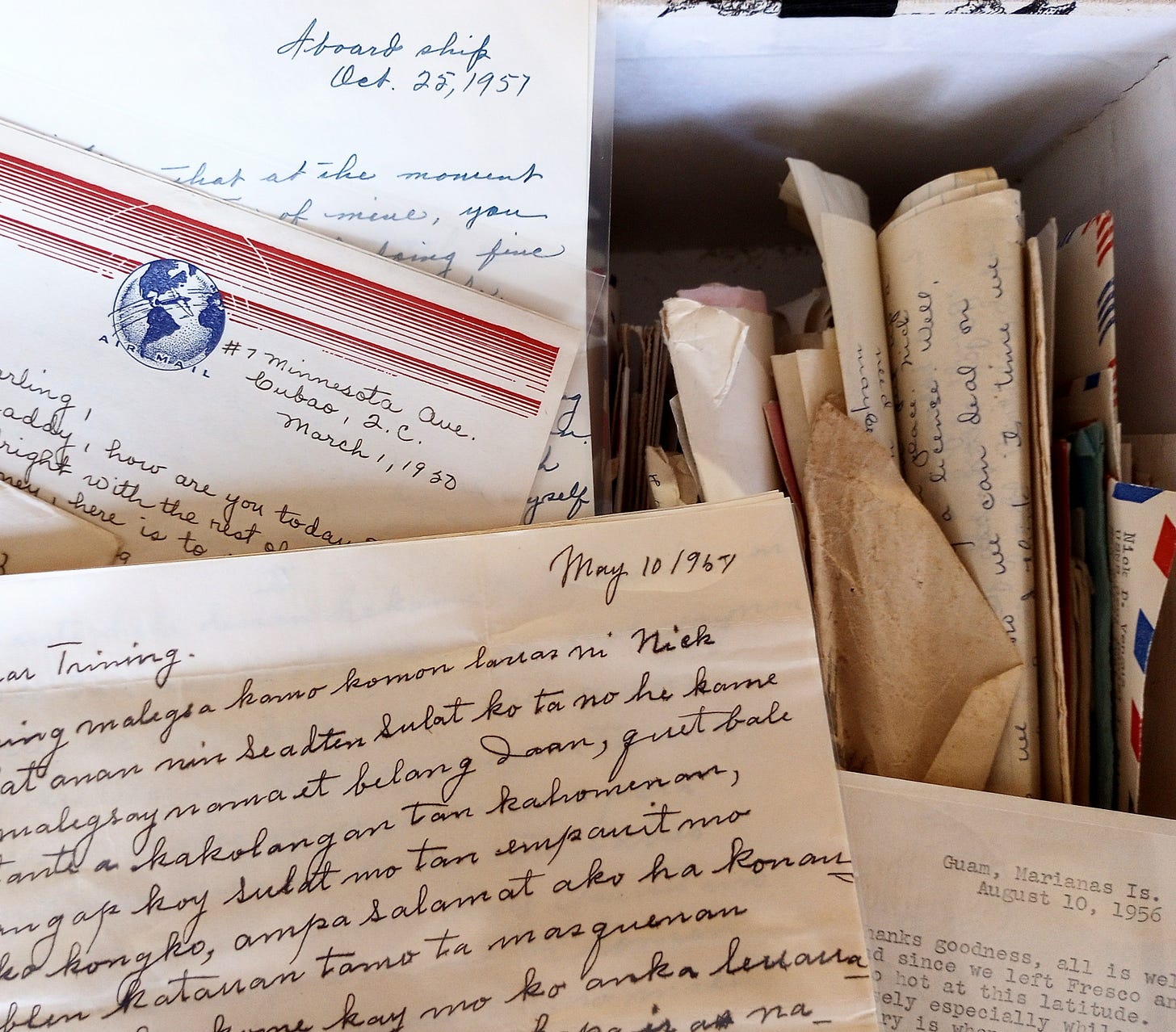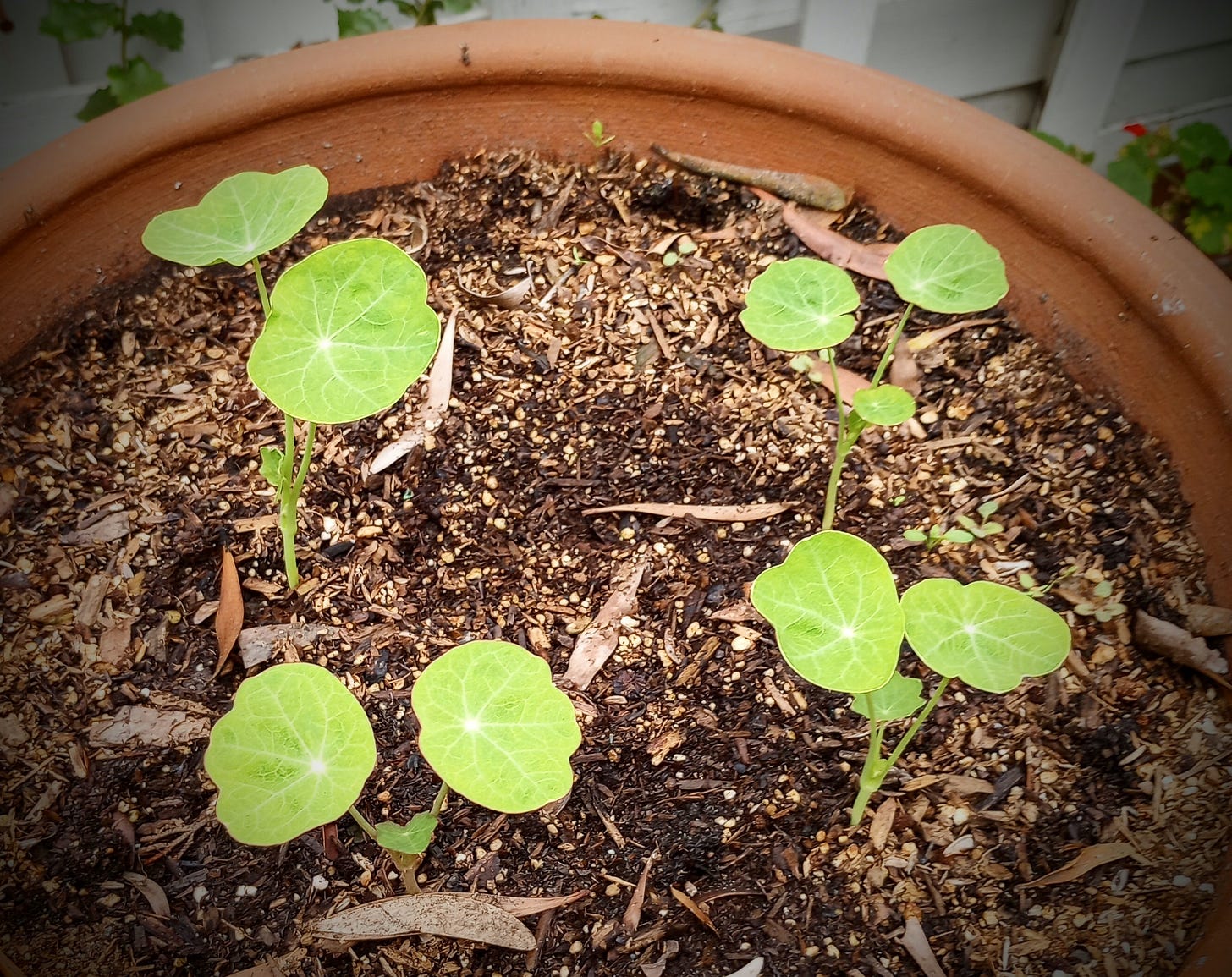Letters from Abroad
#111: Writing, Here & Now, Liu Xiaodong and John Yao, "I need to tell you something" (exhibit), Altina Shinasi & Georg Grosz, Taika Waititi, Keiji Shinohara, Ketty Lester.
WRITING
Finally, after much too long, I have returned to the project of scanning and organizing my parents’ letters for my epistolary writing project. There are so many of them, I can hardly imagine scanning them all. So many old, faded envelopes with the familiar red, white, and blue airmail borders. So many carefully handwritten or typewritten words. So far I’ve read only a handful of them, so I’m approaching this with a little trepidation, but also anticipation. I’m not sure why I’ve waited so long to read them. Perhaps they seemed too private. But now, as my hair turns from salt-and-pepper gray to silver, I feel like it’s time.
Much of the correspondence was routed “c/o USNS [insert ship named after U.S. General or Admiral], Fleet Post Office, San Francisco, California.” As I’m reading, the transitory, liminal nature of my father’s life at sea becomes clearer.1 Each envelope is marked with a stamp from some distant land: the Marianas, Singapore, Manila, Hong Kong . . .
I learn that my father considered me to be a “fragile,” “delicate” child, prone to colds and other ailments. Hmm. I wouldn’t have described myself like that back then—I saw myself as a “tomboy.” But I guess that was after my “sickly” phase.
I also learn that money was a constant concern, mentioned in almost every letter. “Did you receive the money?” “I will send the money soon.” “I wish I could’ve sent you more, but . . .”
There is a letter from my grandmother, Matea Abad Groyon, whom I never met, written in a language I can’t translate on my own (and neither can Google Translate). Is it an older form of Pilipino? Is it some other Philippine language? Cebuano? Ilokano? I’ll need some help with that.
Scanning and reading each letter feels like a journey of ever-shifting proximity and separation, revealed only through the handwritten or typewritten word.
HERE AND NOW
Not much to say about the current moment, except that Trump still manages somehow to turn the spotlight on himself and incite others to behave stupidly, war rages on somewhere, and the town and local businesses are gearing up for the pomp and flashiness of Monterey’s “Car Week.” Oh, and the nasturtiums in my little patio garden are growing very quickly and will likely take over the whole yard in a bid for plant dominance. At least I’d like to think so.
Next up: marigolds.
Anyway, I’m still in “healing” mode, but have been getting out and around nonetheless, thanks to a still-functioning body, my new “Altra Provision 7” (what the hell does that mean, anyway?) shoes, and the Monterey-Salinas transit system.
DOWN THE RABBIT HOLE
Neo-realist painter Liu Xiaodong takes as his subject “ordinary everyday people” around the world, from the U.S.-Mexico border to Beijing (Art21):
See also “Liu Xiaodong’s Empathetic Eye,” by art critic and poet John Yau.
“I need to tell you something,” an exhibition by seven artists that focused on the art and influence of letter writing. At the Sun Valley Museum of Art:
Who was Altina Shinasi? I first heard of Shinasi a couple days ago, when Google dedicated a Doodle to her, the woman who designed the “Harlequin eyeglass frame.” But she was much more than that—an artist, designer, sculptor, filmmaker, and political activist. Shinasi’s mid-century design sense is evident in the trailer for her film, Interregnum, on World War II artist Georg Grosz:
For Letters Live, Taika Waititi reads a hilarious letter about a speeding ticket:
Part of the value of art, for me, is in the way it involves all your senses. Every once in a while I like to post an art process ASMR video. This one is on the traditional art of Japanese Ukiyo-e Printmaking with Keiji Shinohara from the Smithsonian National Museum of Asia. I don’t think it was meant to be ASMR, but the sounds and sights of his process are very sensory:
SOUNDINGS
The one and only Ketty Lester, singing “Love Letters” on Shindig (television series, 1964). This was a new arrangement of a song written in 1945 and sung originally by Dick Haymes. This newer version was recorded by Lester in 1962. The song was also covered by Elvis Presley in 1966.
Thanks for visiting, and thanks to those who have donated to support my work! If you haven’t subscribed, please do—it’s still free!
CommonwealthCafe newsletter
My Ko-Fi page (donations appreciated)
Fediverse sites:
@jeanevergreen at montereybay.social
@jeantangerine on Mastodon.art and PixelFed (alternative to Instagram)
He worked as a messman, cook, and later as chief steward on various merchant marine ships.








Vintage letters are the best. See my Direct Message to you on Instagram. Archival blessing/burden.....